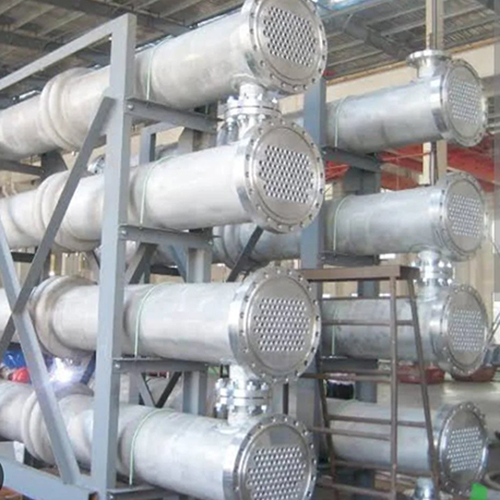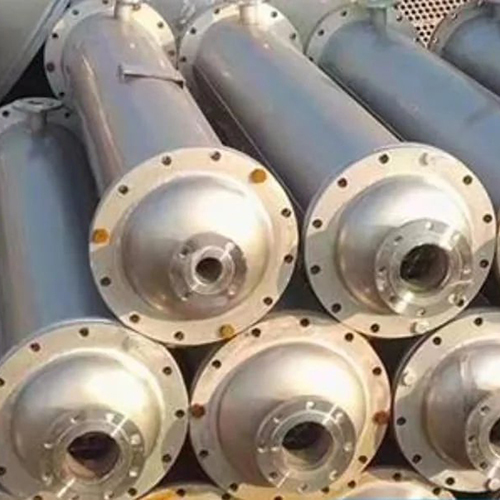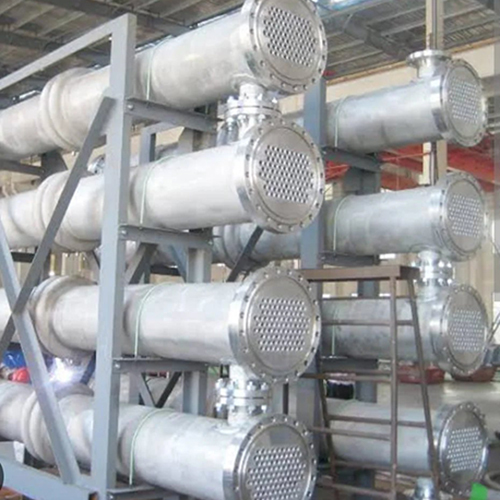Call us
08045478517
The Shell and Tube Heat Exchanger is designed for high-temperature industrial use. With a sleek silver color, this heat exchanger features a tube structure that efficiently transfers heat. Operating at a voltage of 220 Volt, this product is brand new and in top condition. It is perfect for various industrial applications where heat exchange is required.
Manufacturer, Supplier, and Exporter of Shell and Tube Heat Exchanger in India.
Hi-Tech is a reputable entity specializing in the design, production, and export of premium condensers tailored for diverse sectors such as pharmaceuticals, chemicals, and food processing, among others. As a leading manufacturer, supplier, and exporter of condensers, we are dedicated to providing innovative and effective solutions that cater to the unique needs of our clients.
Our condensers are meticulously engineered with an emphasis on precision, durability, and energy efficiency, making them suitable for a diverse array of industrial applications while guaranteeing optimal performance and reliability.
What is a condenser?
A condenser is a vital element utilized in industrial operations to transform vapors into liquids via the condensation process. By extracting heat from vaporized materials, a condenser enables their conversion into liquid state, which is essential for applications such as distillation, solvent recovery, and cooling of reactions.
These systems are offered in a range of designs, including surface condensers, reflux condensers, and air-cooled condensers, addressing the specific requirements of sectors such as pharmaceuticals, chemicals, and food processing.
Key Features of a Condenser
Efficient Heat Transfer:
Engineered to optimize the exchange of heat between vapor and the cooling medium, facilitating swift and effective condensation.
High Cooling Capacity:
Incorporated with sophisticated cooling surfaces or tubes that increase the contact area, thereby providing exceptional cooling performance.
Compact and Space-Saving Design:
Designed for environments where space is limited, maintaining efficiency without sacrificing performance.
Corrosion Resistance:
Manufactured from robust, corrosion-resistant materials to ensure a prolonged service life, even in challenging conditions.
Versatility:
Offered in a variety of configurations to accommodate a broad spectrum of applications across multiple industries.
Energy Efficiency:
Constructed to enhance energy utilization, leading to lower operational costs and a reduced environmental footprint.
Easy Maintenance:
Equipped with easily accessible components that facilitate straightforward cleaning and maintenance, thereby minimizing downtime.
Durability:
Designed to endure the rigors of industrial operations, guaranteeing long-lasting performance and dependability.
Safety Features:
Incorporates safety elements such as pressure relief valves and temperature sensors to ensure safe operation.
Cost-Effective:
Delivers an economical approach to heat exchange and condensation processes.
Advantages of Using a Condenser
Improved Process Efficiency:
Ensures optimal cooling and condensation for a variety of industrial processes.
Enhanced Productivity:
Promotes effective heat exchange, shortening process durations and increasing output.
Reliable Performance:
Robust design guarantees consistent functionality, even in high-demand situations.
Reduced Energy Consumption:
Energy-efficient systems contribute to lower operating expenses and support sustainability initiatives.
Versatile Applications:
Flexible enough to be utilized across various industries and process needs.
Applications of Condensers
Distillation Processes:
Crucial for the separation and collection of components in distillation applications, including chemical synthesis, petroleum refining, and essential oil extraction.
Applications include: -
One fluid flows through the tubing, and the other passes over the tubing (via the shell) to facilitate heat transfer between the two fluids. The group of tubes is called a tube bundle and can be composed of many tube types such as longitudinally finned, plain, etc.
There can be many differences in the shell and tube design. Usually, the ends of all tubes are connected to plenums through holes in tube sheets. The tubes can be straight or U-shaped, called U-tubes.
Most shell and tube heat exchangers are either four, two, or one-pass designs on the tube side. This is the number of instances the liquid in the tubes flows through the liquid in the shell. In single-pass heat exchangers, the liquid goes in one end and out the other of each tube.
In power plants, surface condensers are often one-pass straighttube heat exchangers. However, two and four-pass designs are common since fluid can enter and leave on the same side.
There are often perplexes directing flow in the shell side, so the fluid doesn't cut through the shell side. This leaves poor low flow volumes.
A countercurrent heat exchanger is very efficient since it enables a high log average temperature difference between the cold and hot streams. Most companies nevertheless do not utilize two-pass heat exchangers with a U-tube because they can break easily and are more expensive to build.
To transfer heat well, tube material must have good heat conductivity. Because heat energy transfers from the hot to cold side via the tubes, there's a temperature difference through the tubes' width. Because of the tube material's propensity to expand at different temperatures, thermal stresses happen during operation. This is after any stress from high pressure from the liquids themselves.
Tube material also must be well-matched with both the tube and shell side fluids for long durations in the operating conditions to minimize corrosion. These requirements demand a careful choice of durable, thermally conductive, corrosion resistant, and high-quality tube materials.
Typically metals, like aluminum, stainless steel, copper alloy, non-ferrous copper alloy, carbon steel, Inconel, nickel, titanium, and Hastelloy. Fluoropolymers like PFA and FEP also produce the tube material because of their high resistance to high temperatures.
Many configurations of the parts can be considered. Three primary combinations are presented below.
In this type, the tube sheet and shell are welded together. This leads to an easy and inexpensive structure, and cleaning the tube bores can be done mechanically or chemically. The outer surface of the tubes is, however, inaccessible besides chemical cleaning. Rear headers are common in L, M, and N types.
Any front header can be used here, and the rear header is commonly M-Type. U-tubes allow limitless thermal expansion. The tube bundle can also be excluded for cleaning purposes, and a small bundle to shell clearance may be obtained. Since it is hard to clean inside the tubes using mechanical tools, it's normal to use this type only when the fluid in the tube side is clean.
Here the tube sheet is not welded to the shell but is allowed to move or float. The tube sheet at the front header has a diameter larger than the shell's and is sealed like in the fixed tube sheet. The tube sheet at the back header end has a smaller diameter than the shell and permits the bundle to be drawn out through the shell.
The simple design makes it perfect for cooling for a variety of applications. The most common application is the cooling of hydraulic liquid and oil in combustion engines, transmission, and hydraulic power packs.
With the right selection of material, they can also be applied to heat or cool other mediums, like swimming pools or charge air. In addition, the cylindrical construction of the enclosure is highly resistant to pressure and enables all ranges of pressure applications.
Below are some of the shell and heat exchanger's benefits:
|
Model |
Size |
Capacity kcal/hr |
Capacity kW |
Oil Flow LPM |
|
HTH 2 |
4"X 18" |
1500 |
1.75 |
10-15 |
|
HTH 3 |
4"X 20" |
2400 |
2.8 |
15-30 |
|
HTH 5 |
4"X 24" |
3000 |
3.5 |
20-35 |
|
HTH 7.5 |
4"X 30" |
5000 |
6 |
30-55 |
|
HTH 10 |
6"X 18" |
6000 |
7 |
35-75 |
|
HTH 15 |
6"X 20" |
10500 |
12 |
60-100 |
|
HTH 20 |
6"X 24" |
13500 |
16 |
80-150 |
|
HTH 25 |
6"X 30" |
18000 |
21 |
100-190 |
|
HTH 30 |
8"X 24" |
24000 |
28 |
140-270 |
|
HTH 40 |
8"X 24" |
32000 |
37 |
180-370 |
|
HTH 50 |
8"X 30" |
34000 |
40 |
220-415 |
|
HTH 60 |
8"X 36" |
38000 |
44 |
240-465 |
|
HTH 70 |
8"X 42" |
45000 |
52 |
280-530 |
|
HTH 80 |
8"X 48" |
60000 |
70 |
320-600 |
|
HTH 100 |
10"X 54" |
75000 |
87 |
350-680 |





Price: